Elin Danielson-Gambogi
Elin Kleopatra Danielson-Gambogi (3 September 1861 – 31 December 1919) was a Finnish painter, best known for her realist works and portraits. Danielson-Gambogi was part of the first generation of Finnish women artists who received professional education in art, the so-called "painter sisters' generation". The group also included Helene Schjerfbeck (1862–1946).[1][2]
Elin Danielson-Gambogi | |
|---|---|
.jpg) | |
| Born | Elin Kleopatra Danielson 3 September 1861 |
| Died | 31 December 1919 (aged 58) Antignano, Italy |
| Nationality | Finnish |
| Known for | Painting |
| Movement | Naturalism (arts) and Realism |
Biography
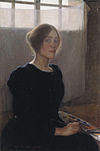
Elin Danielson was born in the small village of Noormarkku, near the city of Pori in Western Finland to Karl Danielson and Rosa Amalia Danielson. Her early years were however spent at Ilmajoki as her father attempted farming there. Because of the Finnish famine of 1866–68, the farm failed. After being forced to sell the farm, her father Karl shot himself.[3] Her mother Rosa returned to Noormarkku with her two daughters.[3]
At the age of 15 she moved to Helsinki and started studying in the Academy of Fine Arts where her teachers included Carl Eneas Sjöstrand (1828–1906) and Hjalmar Munsterhjelm (1840-1905). In 1878, Danielson started courses with Adolf von Becker (1831–1909).[4][5][6]
In 1883 she left for Paris. She took lessons at the Académie Colarossi under Gustave Courtois (1852– 1923) and painted in Brittany during the summertime. A few years later she returned to Finland and lived with her relatives in Noormarkku and Pori. In 1888 she opened an atelier in Noormarkku. During the 1880s and 1890s she also worked as a teacher in several art schools around Finland.[7][8]
In 1895, she received a scholarship and traveled to Florence, Italy. A year later she moved to the village of Antignano in Livorno where she met an Italian painter 13 years younger, Raffaello Gambogi (1874–1943). They began working together and got married in 1898.[3] They held exhibitions in Paris, Florence (where she awarded an art prize by the city[9]) and Milan and in many Finnish cities, and their paintings were also included in the 1900 World's Fair in Paris, where she again won bronze medal. She also got to second place at the 1901 national portrait painting competition organized by the Finnish state.[9] King Umberto even purchased a painting from her.[9]
Their marriage was strained when Raffaello fell in love with her Finnish friend Dora Wahlroos.[10][3] She moved to Finland for a while, but returned in 1903.[10] Because of World War I, her connection to her home land was cut, and by the time she died of pneumonia at Antignano in 1919, she had been mostly forgotten in Finland.[11]
Legacy
Because of her choice of rare subject matters that often caused some offence, she is now seen as one of the central artists of the Golden Age of Finnish Art.[3] Danielson-Gambogi was included in the 2018 exhibit Women in Paris 1850-1900.[12]
Works
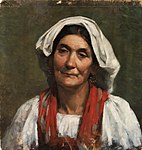 Old Provençal Woman, 1880–1889
Old Provençal Woman, 1880–1889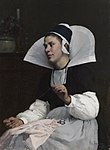 Young mother (Girl from Brittany), 1885
Young mother (Girl from Brittany), 1885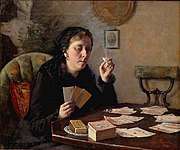 Aunt Balda's Pastime, 1886, one of her subjects that was criticized at the time[3]
Aunt Balda's Pastime, 1886, one of her subjects that was criticized at the time[3] Portrait of Hilma Westerholm, 1888[note 1]
Portrait of Hilma Westerholm, 1888[note 1]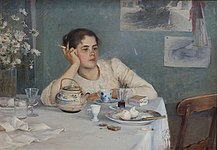 After Breakfast, 1890, of which the artist herself stated that it could have been left unpainted[3]
After Breakfast, 1890, of which the artist herself stated that it could have been left unpainted[3]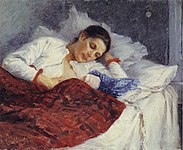 Mother and Child, 1890
Mother and Child, 1890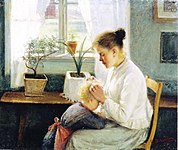 Mother's Care, 1891, the subject of a mother looking for head lice in her child's hair was disturbing to an art critic of Päivälehti[3]
Mother's Care, 1891, the subject of a mother looking for head lice in her child's hair was disturbing to an art critic of Päivälehti[3].jpg) Girl with Cats in a Summer Landscape, 1892
Girl with Cats in a Summer Landscape, 1892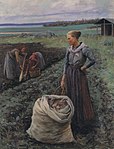 Potato Harvesters, 1893
Potato Harvesters, 1893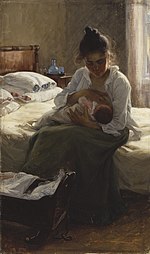 Mother, 1893, a seminal work modeled by the artist's sister[3]
Mother, 1893, a seminal work modeled by the artist's sister[3]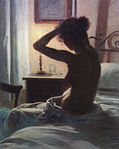 To Bed, 1897
To Bed, 1897.jpg) In the Vineyard II, 1898
In the Vineyard II, 1898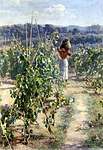 Grape Harvesting, c. 1900
Grape Harvesting, c. 1900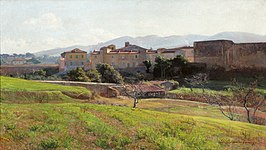 Antignano, 1900
Antignano, 1900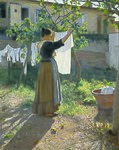 A Sunny Day, 1900
A Sunny Day, 1900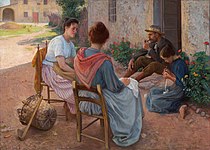 Italian Family, 1900
Italian Family, 1900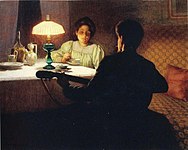 Evening Spell, 1900, with her husband Raffaello Gambogi playing
Evening Spell, 1900, with her husband Raffaello Gambogi playing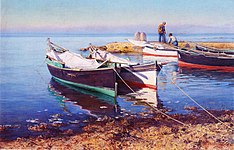 Fishing Boats, 1903
Fishing Boats, 1903.jpg) La Merenda, 1904, with the Antignano beach at Livorno
La Merenda, 1904, with the Antignano beach at Livorno_(cropped).jpg) Engaged, 1906
Engaged, 1906.jpg) The Piano Player, 1907
The Piano Player, 1907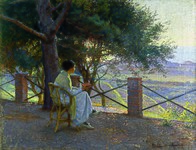 Sunset, 1915
Sunset, 1915_(cropped).jpg) Antignano, 1917
Antignano, 1917
See also
- Golden Age of Finnish Art
- Art in Finland
Notes
- It won a bronze medal at the Exposition Universelle of 1889.[3]
References
- "Elin Danielson-Gambogi". bukowskis. Retrieved January 1, 2019.
- "Helene Schjerfbeck". Biografiskt lexikon för Finland. Retrieved January 1, 2019.
- Kuvaja, Sini (18 February 2017). "Tunnetko tämän taiteen kultakauden mestarin Noormarkusta? Aikansa kapinallinen eli ja maalasi rohkeasti". Satakunnan Kansa. Retrieved 16 May 2020.
- "Carl Eneas Sjöstrand". Biografiskt lexikon för Finland. Retrieved January 1, 2019.
- "Munsterhjelm, Magnus Hjalmar". Nordisk familjebok. Retrieved January 1, 2019.
- "Adolf von Becker". lahteilla. Retrieved January 1, 2019.
- "Elin Danielson-Gambogi". awarewomenartists.com. Retrieved January 1, 2019.
- "Académie Colarossi". tfsimon.com. Retrieved January 1, 2019.
- Konttinen, Riitta (21 October 2015). "Danielson-Gambogi, Elin (1861 - 1919)". Kansallisbiografia. Retrieved 16 May 2020.
- "Danielson-Gambogi Elin". Yle.
- Giovanna Bacci di Capaci Conti, translated by: Catherine Biggerstaff. "Elin Danielson Gambogi". Galleria d'Arte Bacci di Capaci. Archived from the original on October 29, 2013. Retrieved January 1, 2019.
- Madeline, Laurence (2017). Women artists in Paris, 1850-1900. Yale University Press. ISBN 978-0300223934.
External links
| Wikimedia Commons has media related to Elin Danielson-Gambogi. |